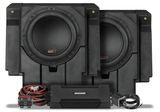Amber or White LEDs? Best Offroad Light Color Temperature
What Offroad Light Should I Buy? | Amber vs White Offroad Lights
Which color is better amber or white when it comes to the headlights? This question has been raised for years by drivers. Although some drivers believe that amber lights are the only way to see it in bad weather, others suggest that white lights are safer and better.
Taylor from KC HiLiTES came up to answer what off-road light do you need? He pointed to the differences between amber and white off-road lights. Remember that can differ from person to person. You have to ask yourself all the questions and think about how you're going to use the lights, and not just rely on someone to tell you the exact light that's going to be perfect for you.
The Basics
The temperature of color is the way the color of the light is measured. The measuring unit for the temperature of the color is degrees, Kelvin. And if you look at the Kelvin scale lower values will be more in the warmer colors like the Amber's and the yellows and the higher values on the Kelvin scale will be of the whites and then the blues and then the violets. Amber lights will be in the range of about 2500 to about 4000 degrees Kelvin whereas there will be a white light in the range of 4,000 to 5,000.
Amber Lights
There are two different ways an off-road light can achieve the amber color.
The first option is to apply some kind of amber cover, which goes over the source of white light. Such amber covers are fantastic because they can minimize a bit of the output from the light itself, so in addition, the advantage of these covers is that you can have an amber light when you need it, but when you don't need it, you can still have white light.
The other way to obtain the amber color is from the real light source. So the halogen light has an LED light source closer to a 3,000 degree Kelvin level. You can select from different colors to get an Amber LED chip.
Pros and Cons
Let's start with some of the downfalls of higher color temperature or cooler light for the pros and cons of these two different colors.
The first major downfall of white lights is that they give less contrast compared to a lower temperature of color or amber light. That is why it is important that the output should have a minimum of blue or violet tint when choosing a white light.
The second big drop in higher color temperature light now is that they have shorter wavelengths resulting in more refraction. what it basically means is that you'll have more glare when you drive in bad weather conditions like dust, rain, snow something like that. More light will bounce back into your eyes from those airborne particles and that's where the amber light really shines through. The amber light has a longer wavelength and it can penetrate a little bit more than the white into some of those airborne particles and this is the main advantage of Amber's.
Now on the flip side, the white lights obviously seem to have much more available light and much more output, even though the actual power going into them is the exact same. So white light will appear to your eye brighter than amber light, but the amber light will definitely excell if there are bad driving conditions, including dust, rain, snow, fog.
What You Need
Choosing an Amber or white light really depends on what you need and what conditions you see when driving. Now with the amber lights with the snap-on cover in amber. It offers you the versatility of having a white light and an amber light when you need it. For those of you who are always in areas with a lot of snow and super dusty during the summer, Amber is a perfect choice for you.
On the other hand, if you're someone who doesn't really face these driving conditions very much then getting a light which is only white is probably good for you.












